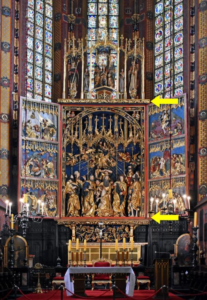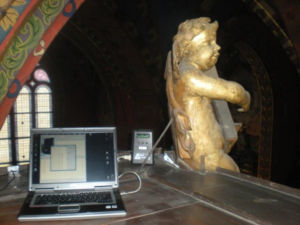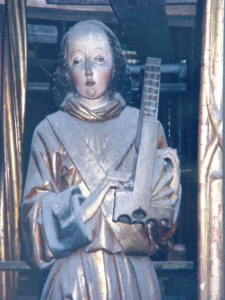Assessing risks to Veit Stoss’s altar in St. Mary’s Basilica in Krakow and a long-term preservation plan for the monument
The late-Gothic main altar carved in lime wood and painted in the years 1477-89 for St. Mary’s Church in Krakow by Veit Stoss and his workshop is one of the most recognizable historical monuments in Poland, and the everyday ceremony of opening its wings at noon, attracting visitors from the whole world, is an element of intangible heritage characteristic of Krakow. In the years 2013 – 2020, experts of the Institute’s Cultural Heritage Group carried out monitoring in the church’s interior with the use of sensor systems for continuous measurements of concentrations of suspended particulate matter and carbon dioxide as well as temperature and relative humidity. Using a specialized software for a comprehensive data analysis, we obtained a description of a relationship between the outdoor environment and the church interior, information on stability of the microclimate in the altar’s environment, as well as on sources, transport and deposition of suspended particulate matter and in consequence the rate of soiling of the sculptures’ surfaces.
Temperature and relative humidity conditions in the altar’s environment
 |
 |
| Arrows mark locations at which environmental parameters were measured close to the altar (left). A case with sensors behind the altar’s back 15 m above the floor (right). | |
The measurements carried out have revealed thermal stratification of air in a such tall interior as the nave of St. Mary’s church – yearly average temperatures were 12 and 15 oC at 2 and 15 m above the floor, respectively, with more humid conditions prevailing in the bottom space of the altar than in the upper (yearly average relative humidities were 70 and 60%, respectively). The band of short-term fluctuations was +/- 15% which, in the light of research, does not endanger polychrome wood. Nor the inflow of persons attending the services and visitors caused increases in relative humidity which could be unsafe to the altar. During conservation works, carried out in years 2015 – 2021, no new damage which could have been induced by relative
humidity fluctuations were revealed. Therefore, one can conclude that the altar has acclimatized over centuries to the local microclimate, though far away from conditions prevailing in museums, and is not at risk of cracking or deformation of wood, nor cracking of the decorative layers.
How quickly does soiling of the St. Mary’s altar proceed?
 |
 |
| A sensor measuring concentration of suspended particulate matter on the church’s choir (left). With time, sculptures of the altar are covered with particle deposits (right). | |
St. Mary’s church seems to be like an unsealed museum display case with fast exchange of air between the inside and outside space, such exchange occurs on average every 3 hours. The suspended particulate matter migrates into the basilica’s interior with air infiltrating through gaps in doors and windows. A fine particle fraction encompassing particles of diameters between 0.1 and 1 micron is largely responsible for altar’s soiling. Fine particles carry a significant part of the total volume and mass of particulate matter, are suspended for long time in air, easily penetrate gaps, and deposit on surfaces indoors in all orientations – vertical and horizontal. Although the city of Krakow has implemented an ambitious programme of improving air quality through the regulatory elimination of outdated heating systems, our models indicate that time to perceptible soiling of the altar, after the conservation finished in 2021, is 15 years whereas time to aesthetically unacceptable change is 55 years. After such time, next full conservation of the altar will be probably necessary to remove particle deposits adhering to surfaces of the sculptures.
The assessment of risks to the altar from the environmental hazards has been complemented by analyses of other risks as wood damaging insects, fires and shocks. Collaboration between Institute’s experts, conservators and services of St. Mary’s basilica has resulted in the development of a comprehensive plan of risk management and long-term protection aimed at preservation of the monument in the best possible state for future generations while maintaining full access to people attending the services and visitors.